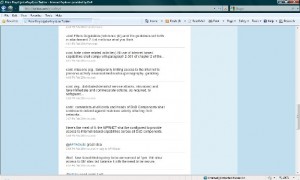My March 2010 video clip of the month is a spoof of the NBC sitcom “The Office” that students at the University of Denver produced to show their frustrations with technology in the classroom.
The video features “Michael,” a technology professor who hasn’t kept up with the latest technology and is trying to wing his technology lectures. At one point, he hands out floppy disks so outdated his students’ laptops don’t even have drives to read them. Later, he tries to be more state-of-the-art and uses the video conferencing tool Skype, except he’s in the classroom simply projecting his face on a giant screen.
One of his students appears to be sleeping during his lectures. Another goofs around on Facebook. Another keeps sending text messages with his phone and complains about being required to buy an expensive laptop and other technologies when the devices are being used for assignments.
In my view, the video illustrates the growing gap between “luddites” and those keeping up with technology. This problem is not necessarily generational and definitely not limited to the field of education! Here’s the YouTube video below. Enjoy!



